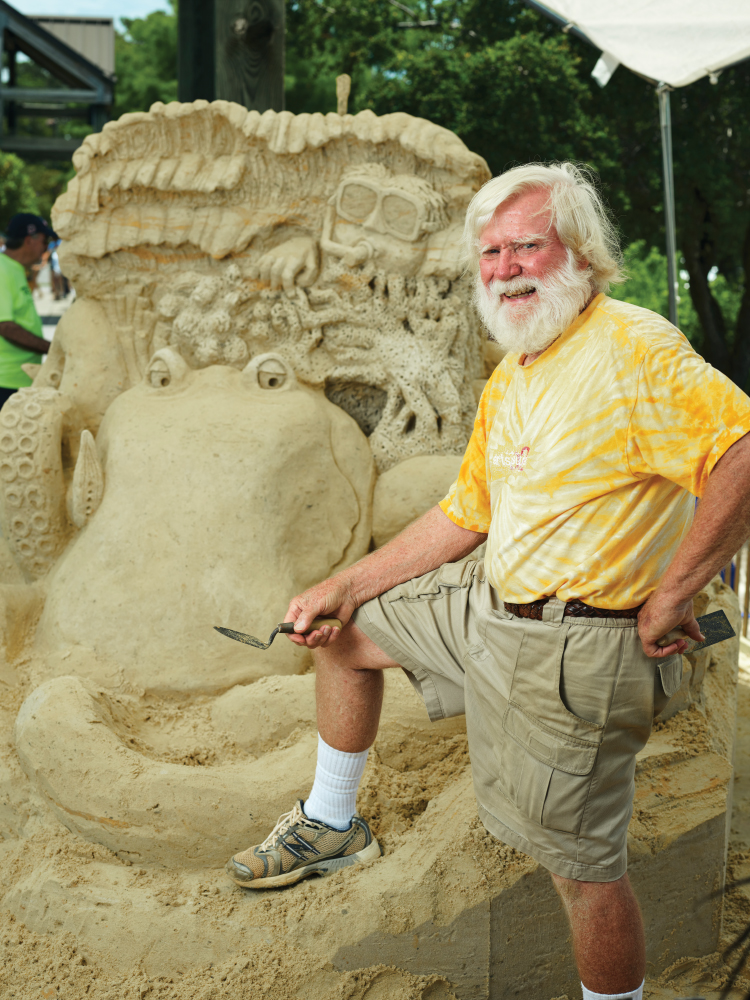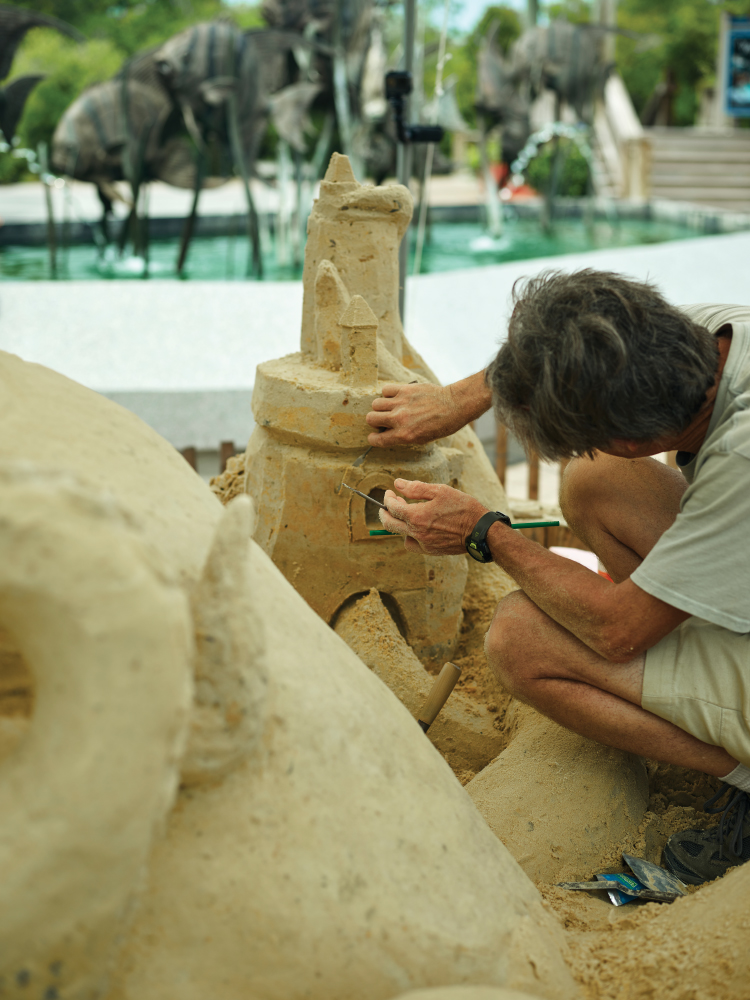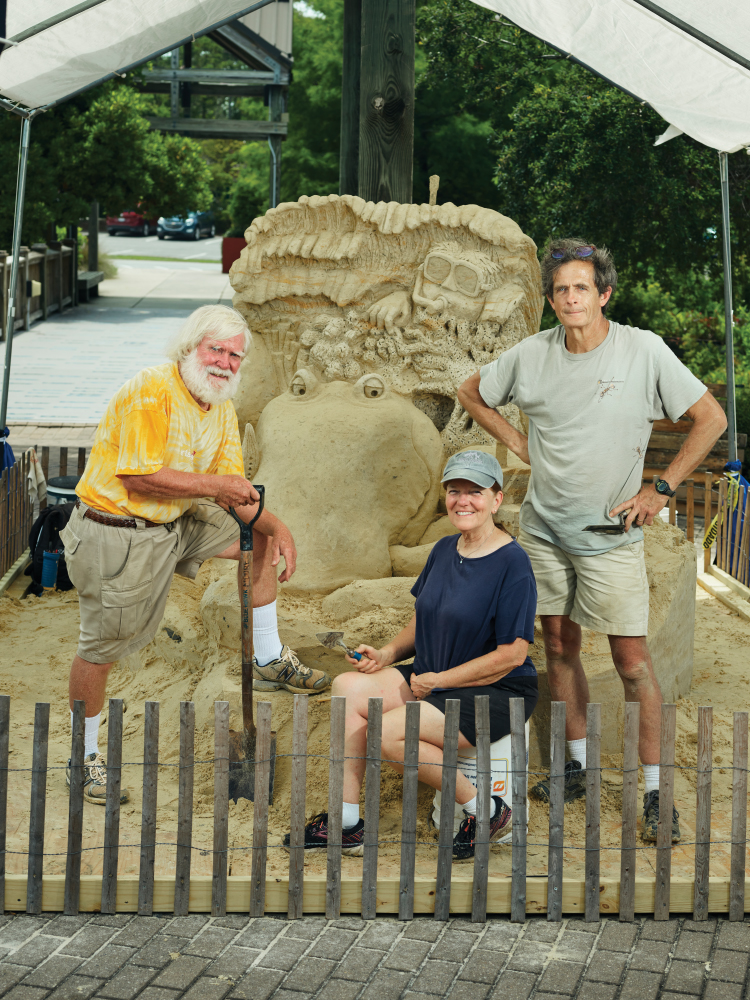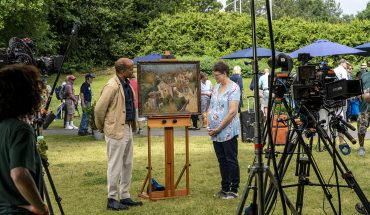Retired architect Ed Moore has made a career carving sand sculptures for festivals like BugFest and Artsplosure
by Ayn-Monique Klahre | photography by Joshua Steadman
You may not know him by name, but you’ve probably seen Ed Moore’s work: gigantic, whimsical sand sculptures that frequently grace downtown street festivals. Moore’s sculptures typically have a sense of humor — ladybugs drinking tea for BugFest, for example, or a bevy of birdhouses for Artsplosure — and are as much fun to watch being made as they are to see as a final product.
An architect by trade, Moore was born and bred in Raleigh. “I had a sand pile when I was 2 or 3 years old, and we were always going to the beach,” he says. He’s always had an interest in sculpture as well, working with wood, clay, and metal.
When his two sons were young, they’d work together with a couple of other families to build epic castles and sculptures on Atlantic Beach, just for fun. About 40 years ago, they entered their first contest, held by the Atlantis Lodge, and then they competed a few times at the Neptune Festival in Virginia Beach. “It’s fun to work this way; you’re not doing it just for yourself, but involving others on the beach,” he says.
As the kids grew up, the group sessions wound down, but Moore’s interest in sand sculpting continued. He kept competing and widened his circuit, eventually making his way to the International Sand Sculpting Contest in British Columbia, Canada. He’s now firmly within a small circle of professional sculptors who work on projects together and, sometimes, compete. “I travel all around the country,” says Moore. “I’ve met people from all over the world doing sand sculpture.”
Now retired from the building industry, what was once a “serious hobby” has turned into something of an encore career. “Some people play golf, I make sand sculptures,” says Moore, who named his sand sculpting company Sandy Feat.
In some ways, architecture and sand sculpture are the same, Moore says: “They are both 3D things and involve work with your hands.” But he likes how sand sculpture is temporary, which allows more room to play and have fun. He also enjoys the team aspect of it. “I typically have about four people all working toward the same thing,” he says, “and they’re all great sculptors.”
One of his 5- to 15-foot sculptures usually takes days to complete, and Moore often enlists the help of passersby to fill the tower of sand that he’ll carve into. “It’s always fun to get different sorts of artists, like painters, to help me — it’s a new medium for them,” he says. “I love to work with other people and share ideas.” Often, he’ll start with a dump truck full of sand (about 16 tons — but he’s done projects with up to 100), then start shoveling it into an open-bottomed box. He’ll add water, then repeat with boxes on top for what looks like a wedding cake made of sand, then carve into that densely packed sand to make his designs.
After decades creating work for the likes of Artsplosure, BugFest, MerleFest, and other events, this past year has been “pretty quiet,” he says. But work is starting to pick up: in June, Moore finished a project for the North Carolina Aquarium at Pine Knoll Shores, and hopes for more to come this fall. “Ed is an absolute delight!” says Jamie Long McCargo, exhibits director at the aquarium. “In the Octopus’ Garden, he carved not only the octopus itself, but fish and sea turtles with playful expressions. He even added a snorkeling child, whose face emerges from the top of the wave and flippered foot and bum stick out the back. It brings many smiles to aquarium visitors and I couldn’t help but giggle as Ed happily pointed it out.”
Kari Wouk, senior manager of educational collaborations at the North Carolina Museum of Natural Sciences, has been working with Moore on BugFest for over a decade. “It’s such a unique and wonderful thing to have a sand sculptor,” she says. “His sculptures are always silly and fun.” Typically, Moore and his team will work on the sculpture for the full day of BugFest, with a sandy area nearby for young ones to “help” as well, then the sculpture stays on display for another two weeks.
“Ed’s a talented conceptual artist and meticulous craftsman,” says Artsplosure executive director Michael Lowder. “His installations are crowd favorites!”
Moore says the sand in the southern North Carolina beaches is better for sculpting than in the northern ones — “It’s flatter and has fewer shells.” — but he uses inland sand for work. “Beach sand has been rolled and rounded; it’s like trying to stack a bunch of marbles,” he says. “Inland you find sharp sand, with flat facets that stick together.”
While most of us aren’t sculpting sand at his scale, Moore does have some tips for the lay beachside sculptor. The first is that more is more when it comes to water. “Take a bucket full of ocean water, then add about half a bucket’s worth of sand,” he says. “Scoop out that really wet sand and plop it in a pile, and when you have a big, wet block of sand, carve into it.” Just about anything can be a tool, from a sharp piece of shell to a plastic spoon, he says. “You really don’t need a lot of equipment.”
Finally, the key to making a sand sculpture look finished, he says, is to “frame” your work. “If you build a little wall around it, people understand that this is your art, and they’re more respectful of it,” he says.
That leads to Moore’s golden rule of sand sculpture: “If you didn’t make it, don’t break it.”
This story originally appeared in our August 2021 issue.






